Visible Measurement of Terahertz Power Based on Capsulized Cholesteric Liquid Crystal Film
Abstract
1. Introduction
2. Materials and Methods
3. Setup and Results
4. Conclusions
Author Contributions
Funding
Conflicts of Interest
References
- Zhang, X.C.; Shkurinov, A.; Zhang, Y. Extreme terahertz science. Nat. Photonics 2017, 11, 16–18. [Google Scholar] [CrossRef]
- Ferguson, B.; Zhang, X.C. Materials for terahertz science and technology. Nat. Mater. 2002, 1, 26–33. [Google Scholar] [CrossRef] [PubMed]
- Hangyo, M. Development and future prospects of terahertz technology. Jpn. J. Appl. Phys. 2015, 54, 120101. [Google Scholar] [CrossRef]
- Kurihara, T.; Watanabe, H.; Nakajima, M.; Karube, S.; Oto, K.; Otani, Y.; Suemoto, T. Macroscopic Magnetization Control by Symmetry Breaking of Photoinduced Spin Reorientation with Intense Terahertz Magnetic Near Field. Phys. Rev. Lett. 2018, 120, 107202. [Google Scholar] [CrossRef] [PubMed]
- Makino, K.; Kato, K.; Takano, K.; Saito, Y.; Tominaga, J.; Nakano, T.; Isoyama, G.; Nakajima, M. Significant volume expansion as a precursor to ablation and micropattern formation in phase change material induced by intense Terahertz Pulses. Sci. Rep. 2018, 8, 2914. [Google Scholar] [CrossRef] [PubMed]
- Wang, L.; Ge, S.; Hu, W.; Nakajima, M.; Lu, Y. Tunable reflective liquid crystal terahertz waveplates. Opt. Mater. Express 2017, 7, 2023–2029. [Google Scholar] [CrossRef]
- Matsui, T.; Mori, H.; Inose, Y.; Kuromiya, S.; Takano, K.; Nakajima, M.; Hangyo, M. efficient optical terahertz-transmission modulation in solution-processable organic semiconductor thin films on silicon substrate. Jpn. J. Appl. Phys. 2016, 55, 03DC12. [Google Scholar] [CrossRef]
- Burford, N.M.; El-Shenawee, M.O. Review of terahertz photoconductive antenna technology. Opt. Eng. 2017, 56, 010901. [Google Scholar] [CrossRef]
- Berry, C.W.; Wang, N.; Hashemi, M.R.; Unlu, M.; Jarrahi, M. Significant performance enhancement in photoconductive terahertz optoelectronics by incorporating plasmonic contact electrodes. Nat. Commun. 2013, 4, 1622. [Google Scholar] [CrossRef]
- Zhang, X.C.; Auston, D.H. Optoelectronic measurement of semiconductor surfaces and interfaces with femtosecond optics. J. Appl. Phys. 1992, 71, 326. [Google Scholar] [CrossRef]
- Nakajima, M.; Takahashi, M.; Hangyo, M. Strong enhancement of THz radiation intensity from semi-insulating GaAs surfaces at high temperatures. Appl. Phys. Lett. 2002, 81, 1462–1464. [Google Scholar] [CrossRef]
- Nakajima, M.; Uchida, K.; Tani, M.; Hangyo, M. Strong enhancement of terahertz radiation from semiconductor surfaces using MgO hemispherical lens coupler. Appl. Phys. Lett. 2004, 85, 191–193. [Google Scholar] [CrossRef]
- Seifert, T.; Jaiswal, S.; Martens, U.; Hannegan, J.; Braun, L.; Maldonado, P.; Freimuth, F.; Kronenberg, A.; Henrizi, J.; Radu, I.; et al. Efficient metallic spintronic emitters of ultrabroadband terahertz radiation. Nat. Photonics 2016, 10, 483–488. [Google Scholar] [CrossRef]
- Qiu, H.; Kato, K.; Hirota, K.; Sarukura, N.; Yoshimura, M.; Nakajima, M. Layer thickness dependence of the terahertz emission based on spin current in ferromagnetic heterostructures. Opt. Express 2018, 26, 15247–15254. [Google Scholar] [CrossRef] [PubMed]
- Hebling, J.; Yeh, K.L.; Hoffmann, M.C.; Bartal, B.; Nelson, K.A. Generation of high-power terahertz pulses by tilted-pulse-front excitation and their application possibilities. J. Opt. Soc. Am. B 2008, 25, B6–B9. [Google Scholar] [CrossRef]
- Hirori, H.; Doi, A.; Blanchard, F.; Tanaka, K. Single-cycle terahertz pulses with amplitudes exceeding 1 MV/cm generated by optical rectification in LiNbO3. Appl. Phys. Lett. 2011, 98, 091106. [Google Scholar] [CrossRef]
- Xie, X.; Dai, J.; Zhang, X.C. Coherent control of THz wave generation in ambient air. Phys. Rev. Lett. 2006, 96, 075005. [Google Scholar] [CrossRef]
- Minami, Y.; Kurihara, T.; Yamaguchi, K.; Nakajima, M.; Suemoto, T. High-power THz wave generation in plasma induced by polarization adjusted two-color laser pulses. Appl. Phys. Lett. 2013, 102, 041105. [Google Scholar] [CrossRef]
- Minami, Y.; Nakajima, M.; Suemoto, T. Effect of preformed plasma on terahertz-wave emission from the plasma generated by two-color laser pulses. Phys. Rev. A 2011, 83, 023828. [Google Scholar] [CrossRef]
- NEC. THz Imager. Available online: http://www.nec.com/en/global/prod/terahertz/ (accessed on 11 December 2018).
- INO. IRXCAM-384 THz Terahertz Camera Module. Available online: https://www.ino.ca/en/products/terahertz-camera-microxcam-384i-thz/ (accessed on 11 December 2018).
- Ophir Photonics. Pyrocam IIIHR Beam Profiling Camera. Available online: http://www.ophiropt.com/laser--measurement/beam-profilers/products/Beam-Profiling/Camera-Profiling-with-BeamGage/Pyrocam-IIIHR (accessed on 11 December 2018).
- TYDEX. Golay Detectors. Available online: http://www.tydexoptics.com/products/thz_devices/golay_cell/ (accessed on 11 December 2018).
- Wang, L.; Urbas, A.M.; Li, Q. Nature-Inspired Emerging Chiral Liquid Crystal Nanostructures: From Molecular Self-Assembly to DNA Mesophase and Nanocolloids. Adv. Mater. 2018, e1801335. [Google Scholar] [CrossRef]
- Schwartz, M.; Lenzini, G.; Geng, Y.; Rønne, P.B.; Ryan, P.Y.A.; Lagerwall, J.P.F. Cholesteric Liquid Crystal Shells as Enabling Material for Information-Rich Design and Architecture. Adv. Mater. 2018, 30, 1707382. [Google Scholar] [CrossRef] [PubMed]
- Keilmann, F.; Renk, K.F. Visual observation of submillimeter wave laser beams. Appl. Phys. Lett. 1971, 18, 452. [Google Scholar] [CrossRef]
- Chen, I.A.; Park, S.W.; Chen, G.; Wang, C.; Bethea, C.; Martini, R.; Woolard, D. Ultra-broadband wavelength conversion sensor using thermochromic liquid crystals. Proc. SPIE 2013, 8624, 862415. [Google Scholar]
- Tadokoro, Y.; Nishikawa, T.; Kang, B.; Takano, K.; Hangyo, M.; Nakajima, M. Measurement of beam profiles by terahertz sensor card with cholesteric liquid crystals. Opt. Lett. 2015, 40, 4456–4459. [Google Scholar] [CrossRef] [PubMed]
- Nakajima, M.; Kurihara, T.; Tadokoro, Y.; Kang, B.; Takano, K.; Yamaguchi, K.; Watanabe, H.; Oto, K.; Suemoto, T.; Hangyo, M. Application of Terahertz Field Enhancement Effect in Metal Microstructures. J. Infrared Milli. Terahertz Waves 2016, 37, 1199–1212. [Google Scholar] [CrossRef]
- Schneider, C.A.; Rasband, W.S.; Eliceiri, K.W. NIH Image to ImageJ: 25 years of image analysis. Nat. Methods 2012, 9, 671–675. [Google Scholar] [CrossRef]
- Goldszal, A.F.; Davatzikos, C.; Pham, D.L.; Yan, M.X.; Bryan, R.N.; Resnick, S.M. An image-processing system for qualitative and quantitative volumetric analysis of brain images. J. Comput. Assist. Tomogr. 1998, 22, 827–837. [Google Scholar] [CrossRef] [PubMed]
- Zhou, X.; He, J.; Liao, L.S.; Lu, M.; Ding, X.M.; Hou, X.Y.; Zhang, X.M.; He, X.Q.; Lee, S.T. Real-time observation of temperature rise and thermal breakdown processes in organic LEDs using an IR imaging and analysis system. Adv. Mater. 2000, 12, 265–269. [Google Scholar] [CrossRef]
- Kang, B.; Takano, K.; Nakajima, M.; Choi, S.B.; Kim, D.; Lee, H. Portable THz imager based on a Metamaterial-Cholesteric Liquid Crystal Hybrid Structure. In Proceedings of the 42nd International Conference on Infrared, Millimeter, and Terahertz Waves (IRMMW-THz), Cancun, Mexico, 27 August–1 September 2017. [Google Scholar]
- Wang, L.; Ge, S.; Hu, W.; Nakajima, M.; Lu, Y. Graphene-assisted high-efficiency liquid crystal tunable terahertz metamaterial absorber. Opt. Express 2017, 25, 23873–23879. [Google Scholar] [CrossRef] [PubMed]
- Kurihara, T.; Nakamura, K.; Yamaguchi, K.; Sekine, Y.; Saito, Y.; Nakajima, M.; Oto, K.; Watanabe, H.; Suemoto, T. Enhanced spin-precession dynamics in a spin-metamaterial coupled resonator observed in terahertz time-domain measurements. Phys. Rev. B 2014, 90, 144408. [Google Scholar] [CrossRef]
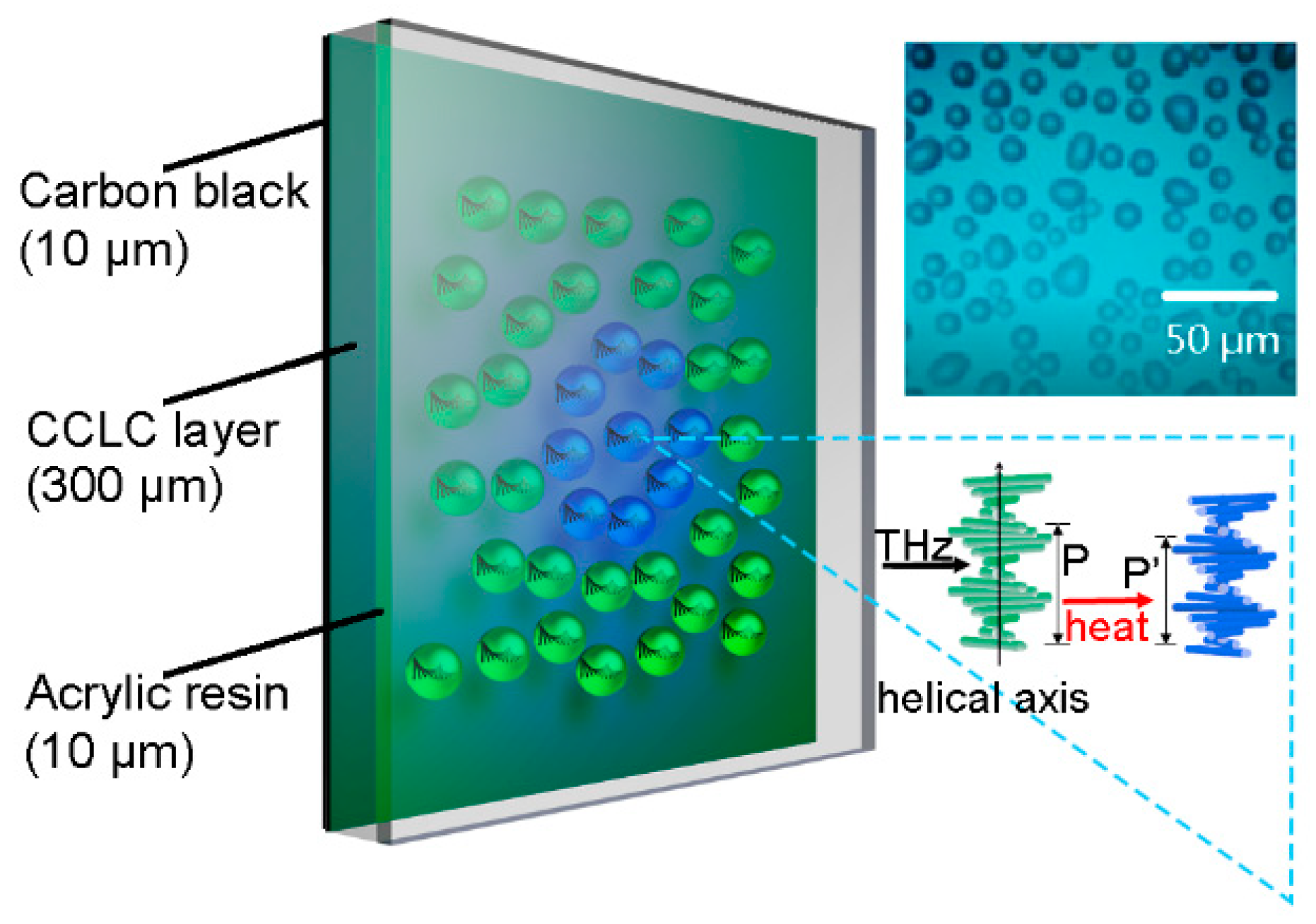
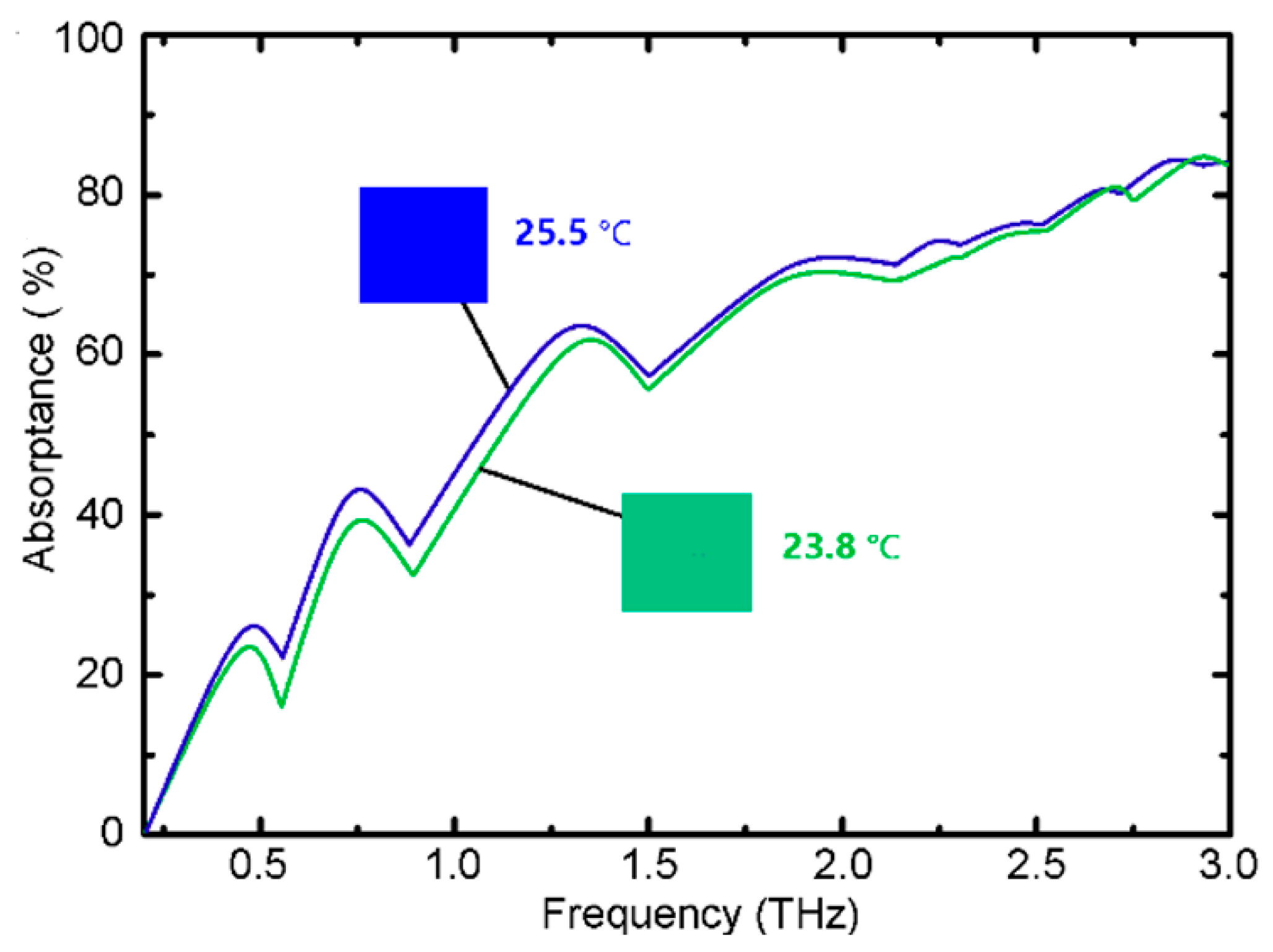
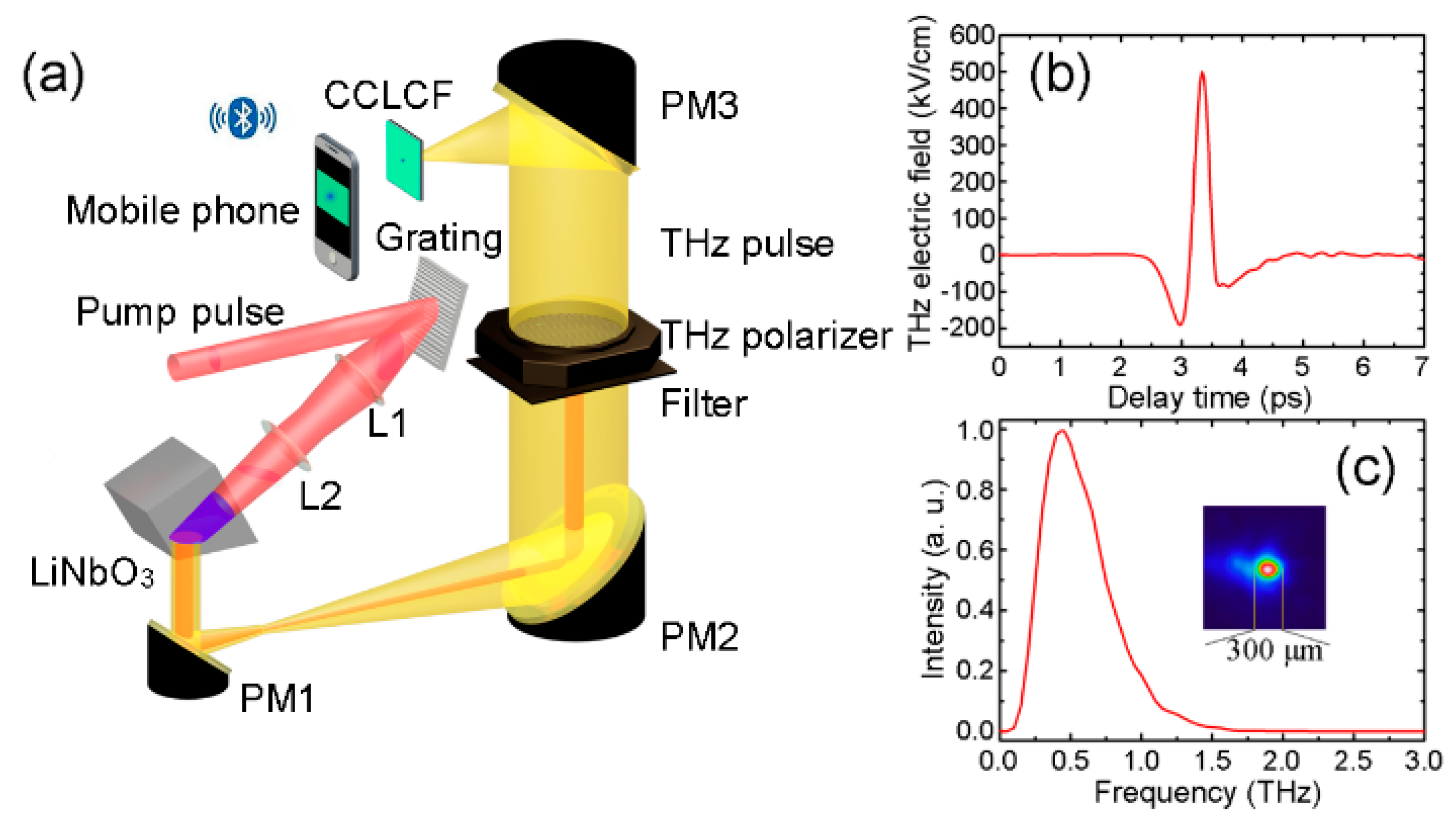
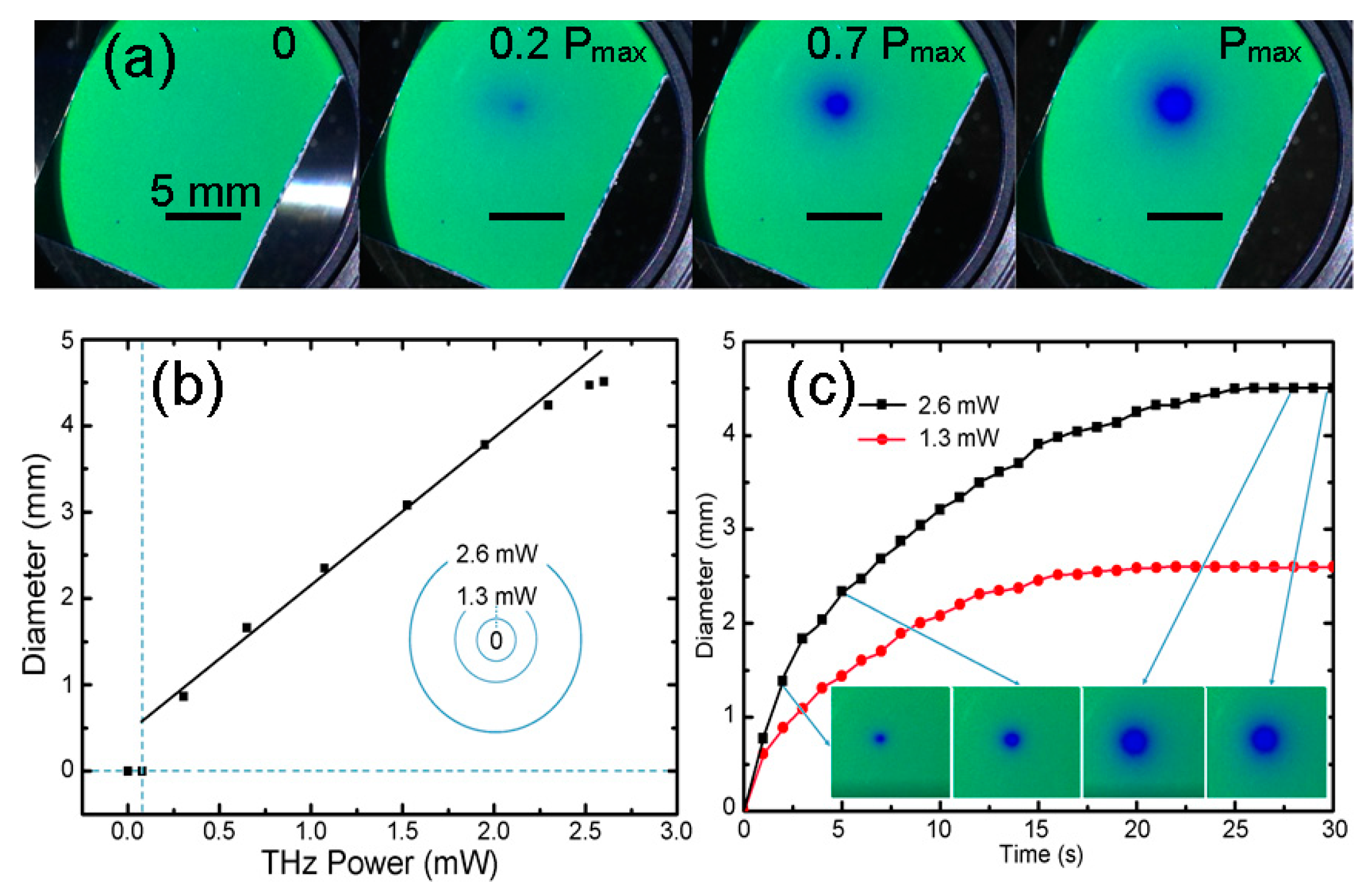
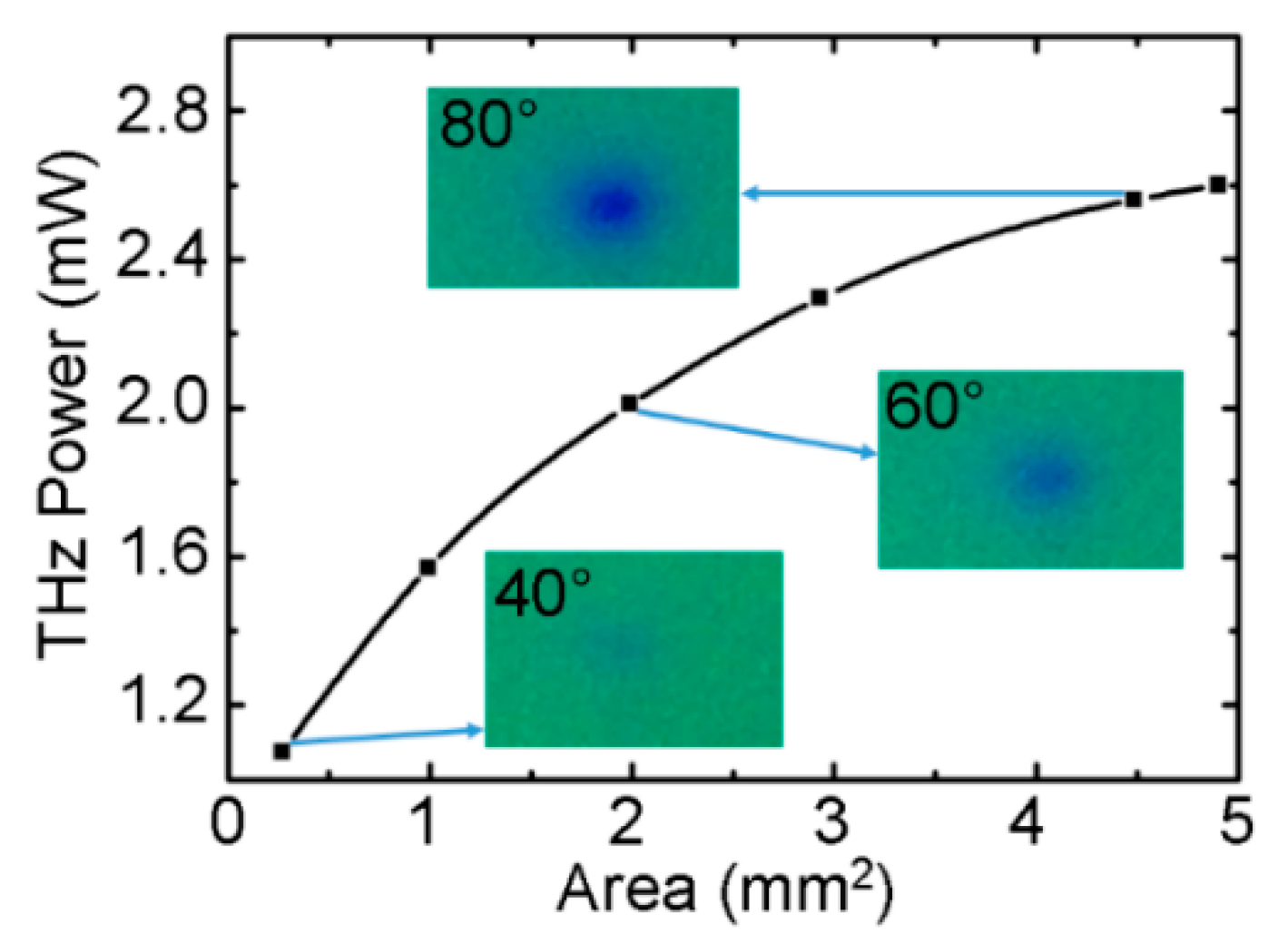
© 2018 by the authors. Licensee MDPI, Basel, Switzerland. This article is an open access article distributed under the terms and conditions of the Creative Commons Attribution (CC BY) license (http://creativecommons.org/licenses/by/4.0/).
Share and Cite
Wang, L.; Qiu, H.; Phan, T.N.K.; Kato, K.; Kang, B.; Takano, K.; Lu, Y.; Chen, L.; Lv, P.; Yu, K.; et al. Visible Measurement of Terahertz Power Based on Capsulized Cholesteric Liquid Crystal Film. Appl. Sci. 2018, 8, 2580. https://doi.org/10.3390/app8122580
Wang L, Qiu H, Phan TNK, Kato K, Kang B, Takano K, Lu Y, Chen L, Lv P, Yu K, et al. Visible Measurement of Terahertz Power Based on Capsulized Cholesteric Liquid Crystal Film. Applied Sciences. 2018; 8(12):2580. https://doi.org/10.3390/app8122580
Chicago/Turabian StyleWang, Lei, Hongsong Qiu, Thanh Nhat Khoa Phan, Kosaku Kato, Boyoung Kang, Keisuke Takano, Yanqing Lu, Lujian Chen, Peng Lv, Kehan Yu, and et al. 2018. "Visible Measurement of Terahertz Power Based on Capsulized Cholesteric Liquid Crystal Film" Applied Sciences 8, no. 12: 2580. https://doi.org/10.3390/app8122580
APA StyleWang, L., Qiu, H., Phan, T. N. K., Kato, K., Kang, B., Takano, K., Lu, Y., Chen, L., Lv, P., Yu, K., Wei, W., Jin, B., & Nakajima, M. (2018). Visible Measurement of Terahertz Power Based on Capsulized Cholesteric Liquid Crystal Film. Applied Sciences, 8(12), 2580. https://doi.org/10.3390/app8122580



